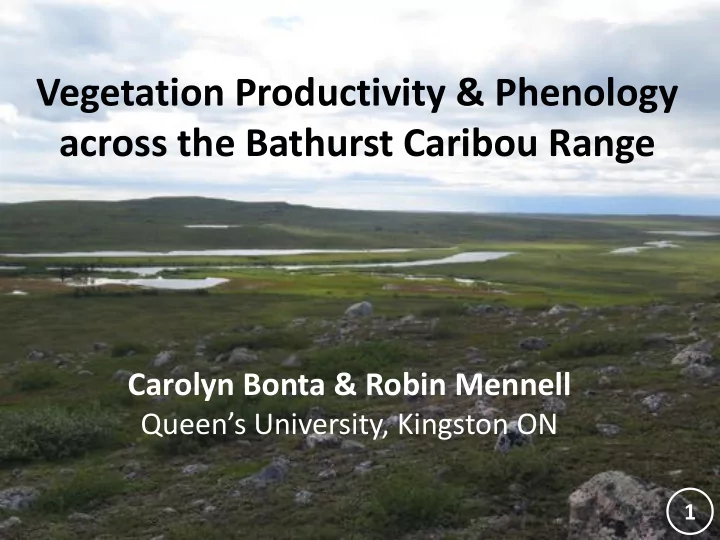

Vegetation Productivity & Phenology across the Bathurst Caribou Range Carolyn Bonta & Robin Mennell Queen’s University, Kingston ON 1
A Changing Arctic Climate 2 Maximum NDVI Percent change 1982-2008 Bhatt et al. (2010), Earth Interactions , 14: 1-20.
Vegetation Productivity 3 (NIR – Red) NDVI = (Red – NIR) HIGH in dense vegetation LOW in sparse areas
What’s Happening ‘On the Ground’? 4 Tremblay et al. 2012. Env Res Lett 7: 035501. Fraser et al. (2011), Env Res Lett 6: 045502
5 GNWT. 2018. Draft Bathurst Caribou Range Plan. Bathurst Caribou Herd
Bathurst Caribou Herd 6 Figure 1. Estimates of Bathurst caribou population size Figure 2. A conceptual scientific model of factors and number of breeding female from 1986 – 2105. affecting barren-ground caribou and their habitat, and effects on population. GNWT. 2018. Draft Bathurst Caribou Range Plan.
Hypothesis 7 A change in the structure, composition and/or growth of vegetation in response to climate change is responsible for the decline of the Bathurst caribou herd.
Project Objectives 8 1. Map and analyze changes in ecosystem productivity and phenology using satellite remote sensing 2. Link these changes to field conditions using dendrochronology 3. Assess linkages with changes in herd distribution and habitat use with geospatial analysis
Common NDVI Products 9 AVHRR MODIS LANDSAT Hyperspatial (various) NDVI Spatial 1000 (but 250 30 <4 Resolution (m) effectively 8000) Revisit Time 1.5 days 1 day 16 days <3 days (pointable) Available since 1981 2000 1982 ca. 2000 2400 x 6400 1100 x 1100 Image Size 170 x 180 <10 x 10 (km) Cost per image $0 $0 $0 >$2000
Challenge of Revisit Time… 10
11
Dendrochronology 12 Q. Why not just use satellite imagery? A. Without field sampling, we don’t know what is actually changing • Woody vegetation could be encroaching into tundra or increasing in density; or pre-existing vegetation could be growing more • Growth ring analysis permits assessment of these over the lifetime of the tree or shrub
13
MacKay Lake NDVI Trends 14
Research Expedition 15
Research Expedition 16
Site Sampling Objectives 17 1. Vegetation characterization 2. Shrub stem analysis 3. Shrub dendrochronology Tree dendrochronology
Vegetation Characterization 18
Shrub Stem Analysis 19
Shrub Dendrochronology 20
Shrub Dendrochronology 21
Tree Dendrochronology 22
Caribou Movement and Migration 23 Photo’s taken from Environment and Natural Resources NWT
Belt Transects 24
This is Project #187 of the Government of the Northwest Territories Department of Environment and Natural Resources Cumulative Impact Monitoring Program. Project website: rangechange.ca ryan.danby@queensu.ca / 613-533-6000 x78540
Recommend
More recommend